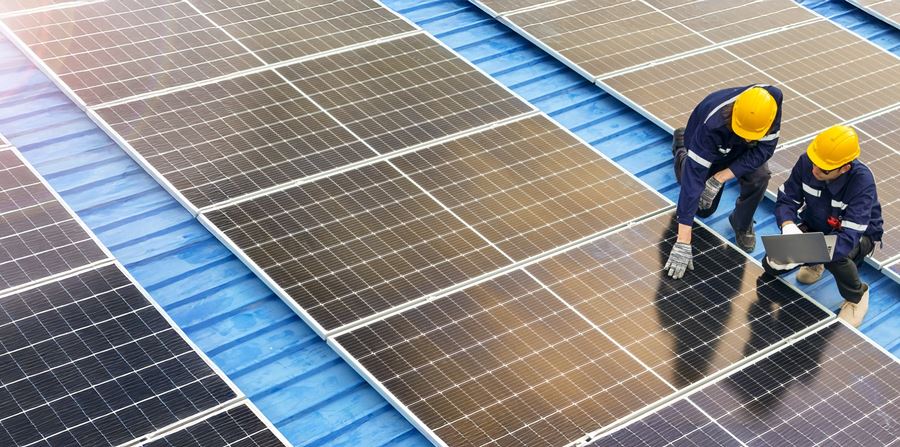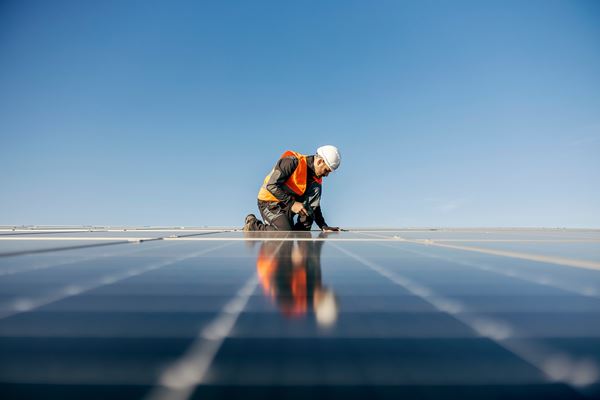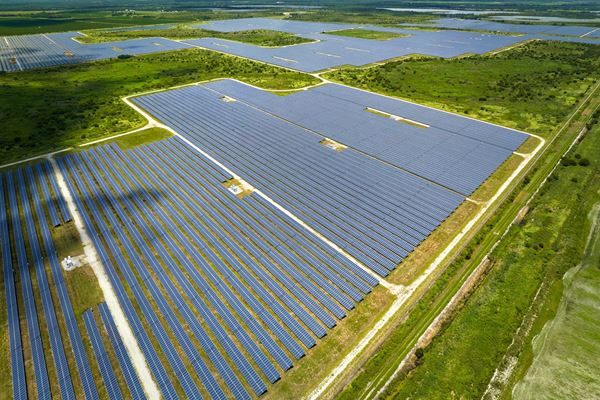PV Module Reliability Issues: Understanding Backsheet Degradation and Claim Disputes

A photovoltaic (PV) module, commonly known as a solar panel, is composed of multiple layers. One critical layer is the backsheet[1], which protects the internal components from environmental contamination. Failure of the backsheet allows humid air to enter the module, resulting in water condensation.
The presence of liquid water inside the panel causes corrosion and reduces the insulation resistance between the panel circuitry and the grounded frame. When ground current increases beyond the string inverter’s ground fault threshold, the inverter shuts down, taking the entire string offline.
Failure Mechanism Implications
This failure mechanism has a few notable implications:
- Intermittent Functionality: Modules with failed backsheets may still function intermittently, depending on the environmental humidity and temperature.
- Non-Obvious Failure: Backsheet failure may not be visually apparent. Service technicians may observe recurring ground faults without apparent cause.
- Cascading Impact: The ground fault from one failed module backsheet will cause the entire string to stop producing, despite all other modules being intact and functional.
A single backsheet failure is unlikely to result in an insurance claim. However, there are cases when numerous backsheets across an installation fail due to long-term degradation. These large-scale failures can impact insurance claims:
- Property loss claims for the replacement of modules with failed backsheets.
- Demolition and reinstallation cost claims for labor costs after the manufacturer has honored a warranty claim for replacement modules.
- Business interruption claims for lost energy generation capacity.
- Complication of loss calculations for claims resulting from other causes, such as hailstorms. The pre-existing decay to the backsheets impacts both lost production and watt-for-watt replacement calculations.
Additionally, at least one manufacturer issued safety guidance for handling PV modules with degraded backsheets, citing electric shock risks during removal.
Because backsheet degradation losses can be costly and may not be covered under standard policies, coverage disputes are more likely to result in litigation. A better understanding of backsheet degradation can assist in processing and resolving claims of this nature.
Causes of Backsheet Degradation
PV module backsheets are typically made of flexible plastic materials, with the most commonly used being:
- Polyamide (PA)
- Polyethylene Terephthalate (PET)
- Polyvinylidene Fluoride (PVDF)
- Polyvinyl Fluoride (PVF)
- Polytetrafluoroethylene-co-hexafluoropropylene-co-vinylidene fluoride (THV)
- Fluorinated Coating (FC)
- Co-extruded Polyolefin (PO)
- Ethylene Chlorotrifluoroethylene (ECTFE)
Among these, PA and FC backsheets have been documented as particularly prone to degradation (Raymond J. Wieser, 2023; Claudia Buerhop, 2021; Claudia Buerhop-Lutz, 2021). PA backsheets were widely used in PV modules manufactured between 2010 and 2012.
One contributing factor to backsheet degradation is chemical attack from within the module. Within the PV module is another material, the encapsulant. One common encapsulant is ethylene vinyl acetate (EVA), which partly decays over time in the presence of sunlight, forming acetic acid. The acetic acid attacks the backsheet materials, resulting in degradation and cracking (Yadong Lyu, 2020; Farrukh ibne Mahmood, 2023). Newer evidence indicates that PET backsheets are also vulnerable to such chemical attack (Fanqi Zeng, 2024), further expanding the scope of potentially defective module designs.
Since these failures result from the use of materials that are inherently incompatible, they generally constitute a defect in module design, rather than wear and tear or external damage. At least one manufacturer has been willing to honor warranty claims for large-scale backsheet degradation, while demanding only minimal documentation to justify the scope of the claim. This implies the manufacturer may have extensive prior experience handling such defect claims.
A recent study analyzing 1.9 million PV modules across 197 installations found that backsheet defects impacted 7.6% of modules (Khan et al., 2024). These types of failures are expected to persist until aging installations are replaced with more durable module designs.
Case Studies
A study (Julio Pascual, 2023) of an eight-megawatt solar facility installed in 2011 documented serious ground fault issues emerging by 2016. A detailed analysis found that the facility’s modules with PA backsheets could be divided into two groups based on serial numbers. One group of PA modules exhibited visible cracks in 9.4% of their backsheets, while another group of PA modules exhibited cracking in only 0.4%, and FP modules exhibited no backsheet cracking. This suggests that even within modules of the same make and model and using the same backsheet material, there are additional factors contributing to the rate of backsheet decay that may not be so easily identified.
Another study (Claudia Buerhop-Lutz, 2021) analyzed a five-megawatt solar facility installed in 2012 and found multiple backsheet materials in modules of the same make and model. Degradation was found in both PA and FC backsheets. PET backsheets exhibited no reported problems.
In an Envista case study, three one-megawatt generating facilities installed in 2015 began experiencing widespread ground faults around 2021. Inspections found extensive backsheet cracking, with failure rates of about 65% in two of the facilities, and 98% in the third facility. Notably, there was no apparent environmental or equipment difference between the installations, and modules with higher serial numbers were significantly less likely to exhibit cracking. Envista was not permitted to conduct testing to identify the backsheet materials involved. However, the observed degradation patterns closely matched previous studies on PA and FC backsheet failures.
Collectively, these case studies demonstrate that manufacturing variations can significantly impact long-term reliability, even in nominally identical installations.
Solar Panel Claim Implications
In forensic claims analysis, it is essential to consider each case individually; investigations must remain objective, without preconceived conclusions. Still, claims involving backsheet degradation frequently raise similar policy questions that must be addressed:
- Is the cause of loss backsheet degradation? Consider:
- What are the effects being claimed as failure? Cracked backsheets and/or recurrent ground faults are key.
- How long have the modules been installed?
- Are the failures progressive or sudden?
- What is the chemical composition of the backsheets? (May require destructive testing.)
- Are failures predominantly associated with particular model number or serial number batches?
- Are there unusual environmental factors at this installation?
- Are there any recalls or defect notices from the module manufacturers involved?
- What constitutes an individual claim? If a hundred modules fail due to a common design defect, should that be treated as a single loss event (one claim, one deductible) or as a hundred separate losses? If the latter, it is almost certain that the value of each individual claim would be below the policy deductible.
- Standard equipment breakdown policies are designed for sudden failures. However, backsheet degradation occurs gradually over time. If backsheet degradation is found to be the cause of loss, the loss is, by definition, not an equipment breakdown under most policies.
- Since a module can have a cracked backsheet and continue to function, does a cracked backsheet constitute a covered loss? Or is coverage only triggered by loss of function?
- If loss of function is the determining factor for coverage, how does the policy handle intermittent loss of function, such as ground faults, dependent on environmental humidity? Would repeated temporary interruptions qualify as a covered event?
- Even if property and equipment breakdown coverage is denied, could business interruption coverage still apply?
- If so, how can the business interruption be effectively mitigated?
- If coverage is found for a cracked backsheet, what is appropriate remediation?
- Studies are exploring potential repair methods for cracked backsheets (Yuliya Voronko, 2021), but no data supports their long-term reliability. Further, repair services for degraded backsheets may be scarce or unavailable, leaving module replacement as the only viable option.
- Variations in module dimensions, electrical characteristics, or mounting parameters can significantly increase costs beyond simple module replacement.
Backsheet degradation not only affects direct claims, but it can also complicate claims related to external damage, such as hailstorms. It is common for damaged PV modules to be replaced on a watt-for-watt basis, accounting for the typical 1%-per-year degradation of the PV modules to estimate their actual generation capacity at the time of loss. If the module backsheets were degraded and cracked prior to the loss, the modules may have experienced additional generation losses due to contamination and corrosion.
This raises a key claims issue: should replacement calculations be based on the theoretical efficiency of intact modules, or the actual performance of the degraded system at the time of loss? Indeed, degraded modules may have been rendered entirely non-functional prior to the claimed loss by contamination and persistent ground faults! Obtaining records of energy generated by the installation is critical in such cases.
Conclusion
PV modules using certain combinations of backsheet material and encapsulant are highly susceptible to chemical degradation, leading to large-scale material failures and financial losses. This type of failure is not typically covered under standard insurance policies, increasing the likelihood of legal disputes between insurers and policyholders. Given this risk, proper forensic investigation and documentation of the failure mode are critical if a claim is to be denied or disputed.
Additionally, insurance carriers may benefit from proactively notifying policyholders about this issue, both to help mitigate potential losses and to set realistic expectations when degradation-related claims arise. As the installed base of affected modules continues to age, this issue is expected to persist, making clear risk assessment and claim evaluation increasingly important.
Why Work with Envista Forensics?
When it comes to complex claims involving PV module backsheet degradation, having the right forensic partner can make all the difference. Envista Forensics has deep experience investigating solar system failures, assessing material degradation, and providing clear, defensible analyses that help resolve coverage disputes.
Our multidisciplinary team of experts includes engineers and materials scientists who understand both the technical nuances of photovoltaic systems and the intricacies of insurance claims. Whether you're facing recurring ground faults, evaluating potential design defects, or seeking clarity in claim attribution, Envista delivers trusted insights grounded in science and experience.
If you're navigating claims involving solar infrastructure or need expert guidance in evaluating module failures, contact Envista Forensics. We’re here to help you protect your investments, support sound claim decisions, and mitigate risk with confidence.
Bibliography
Claudia Buerhop, O. S. (2021). Wet leakage resistance development of modules with various backsheet types. Progress in Photovoltaics, 938-947.
Claudia Buerhop-Lutz, O. S. (2021). PV modules and their backsheets - A case study of a Multi-MW PV power station. Solar Energy Materials and Solar Cells.
Fanqi Zeng, Y. H. (2024). Accelerated degradation of PET-based photovoltaic backsheets under UV and acetic acid exposure. Polymer.
Farrukh ibne Mahmood, G. T. (2023). Impact of different backsheets and encapsulant types on potential induced degradation (PID) of silicon PV modules. Solar Energy, 20-28.
Julio Pascual, M. G. (2023). Analysis of polyamide and fluoropolymer backsheets: Degradation and insulation failure in field-aged photovoltaic modules. Progress in Photovoltaics, 494-505.
Khan, Z. U., Khan, A. D., Khan, K., Khatib, S. A., Khan, S., & Khan, M. Q. (2024). A Review of Degradation and Reliability Analysis of a Solar PV Module. IEEE Access, 185036-185056.
Raymond J. Wieser, Y. W.-T. (2023). Field-retrieved photovoltaic backsheet survey from diverse climate zones: Analysis of degradation patterns and phenomena. Solar Energy, 49-62.
Yadong Lyu, A. F. (2020). Drivers for the cracking of multilayer polyamide-based backsheets in field photovoltaic modules: In-depth degradation mapping analysis. Progress in Photovoltaics, 704-716.
[1] Newer manufacturing techniques offer glass-glass modules, where the traditional backsheet is replaced with another layer of glass. This improves the rigidity of the module, reduces vulnerability to backsheet degradation, and can increase energy capture.
Our experts are ready to help.



